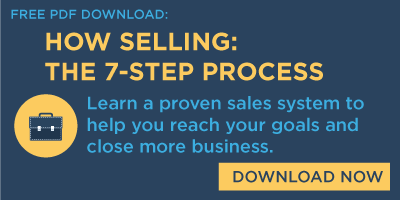 Think about a typical sales engagement. You’re trying to win the same business that your key competitor is hoping to get their hands on. You spend a massive amount of time and energy trying to prove why your product, service, or company deserves the business over your competitor. In other words, you’re trying to prove you’re better.
Think about a typical sales engagement. You’re trying to win the same business that your key competitor is hoping to get their hands on. You spend a massive amount of time and energy trying to prove why your product, service, or company deserves the business over your competitor. In other words, you’re trying to prove you’re better.
Then, when it comes down to the transaction, you learn the prospect is considering both options, and you are tempted—by either the prospect or your own paranoia—to drop your price.
Occasionally, there’s a good reason to lower your price… perhaps to clear excess inventory or to grab a rare opportunity to increase share of customer. But most price-cutting is the result of a weak sales strategy that gets rationalized away with fancily-phrased excuses.
Beyond the obvious downside that dropping your price produces less revenue per unit and less profit while leaving you further from goal, there is one really compelling reason to avoid trying to nail a deal on the basis of price:
It stands in contrast to everything you’ve discussed with the prospect so far.
Think about it. You’ve spent so much time and effort laying the foundation for a sale (and a relationship!) built around quality. You’ve proven your expertise, your problem-solving capability, and your value as a partner. You’ve explored challenges or opportunities the prospect has, and you’ve explained how solution suits those needs precisely and profitably. Implicit in all of this is that your offering is worth more than others available to the prospect.
And now you’re going to undermine all that hard work and smart strategy by announcing that your solution is worth less?
Please don’t. Unless you’re prepared to walk out of the office without your credibility.
If you want to avoid selling on price, you need to pursue that strategy from the very beginning of the selling process.
Finding: When you prospect, look for accounts that conform to your ideal customer profile The better the fit, the less need there is to accommodate the fit by adjusting the price.
Selecting: You’re likely to come across a lot of accounts, but when it comes to selecting true target accounts, get fussy. Pay particular attention to:
- Dollar potential. Does the prospect have the kind of budget that will be required to profitably invest in the solution you develop?
- Product fit. Is it plausible—or better yet, likely—that your assets can be configured and deployed in a way that will solve this prospect’s problem?
- Value-added fit. By value-added, we’re not especially referring to any bonus product or free services you’re willing to toss in. Rather, we’re talking about the unique ways you do business, support your clients, and make your solutions more valuable. If these are things this prospect appreciates and values, then you have a strong value-added fit.
Avoiding the trap of having to drop your price starts with finding and selecting the right prospects in the first place. But it doesn't stop there.
Engage
Are you engaging this prospect—right from the start—in a way that demonstrates professionalism and positions you as a valuable business partner? A great approach isn’t just about getting your foot in the door. It’s about getting the prospect into the frame of mind they’ll need to be in to make that very first meeting a productive one. This valuable professional partner approach to the client should influence every meeting and interaction thereafter.
Ask smarter questions
As you move through the needs analysis process, think about the information you hope to harvest with each question you ask. And realize that your goal is not just to fill a meeting with intelligent questions; it is to get the prospect to provide meaningful answers that lead to a complete and useful definition of the challenge you will ultimately help him or her solve.
Position yourself
By this time, you have positioned yourself well and probably have the upper hand over competitors—because the salesperson who best understands the challenge faced by the prospect is best suited to solve it. By now, your prospect should be truly collaborating with you and so focused on the solution you’re building together that value has become more relevant than price. Because you have a unique understanding of the problem and you are working closely with the prospect, the solution you’re developing will be very difficult for anyone else to replicate.
Commodities are distinguished only by price, and thus are subject to brutal price wars, relieved only if supplies of the commodity run short. But comprehensive, tailored solutions are just the opposite: Unique, perfectly-fitted, not substitutable, and able protect themselves against price-cutting.
Savvy salespeople don’t strategize about price toward the end of the sales process, but from the very outset.
If you'd like to learn more about bringing customers to you, download the "Steps of How Selling" PDF.

